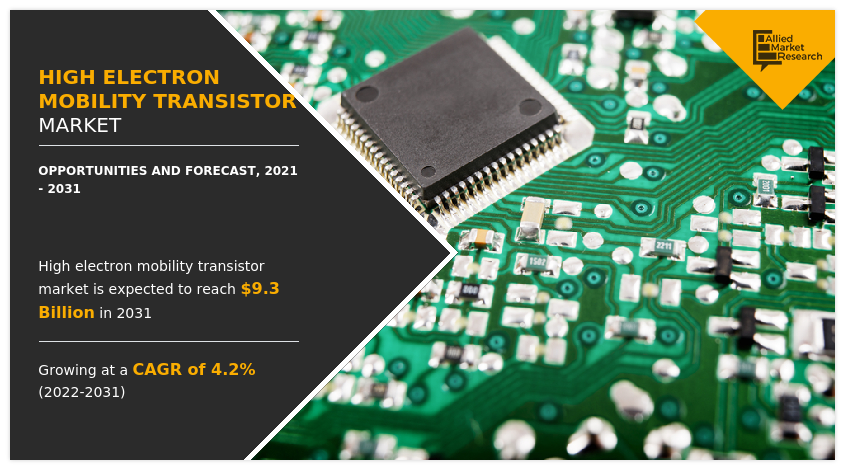High Electron Mobility Transistor Market Statistics - 2031
The global high electron mobility transistor market size was valued at $6.2 billion in 2021 and is projected to reach $9.3 billion by 2031, growing at a CAGR of 4.2% from 2022 to 2031. A high electron mobility transistor (HEMT) is a field effect transistor that incorporates a junction between two types with different band gaps as the channel instead of a doped region. The primary characteristics of a HEMT device include operation at higher frequencies, thus increasing its applications in high-frequency equipment like mobile phones, satellite television receivers, voltage converters, and radar equipment.
Ample investments and developments of HEMTs by key players are expected to drive the growth of the HEMT market. However, the lack of standard techniques to produce and develop HEMT devices is expected to pose one of the major threats to the market. Furthermore, the high demand for new HEMT technologies in the aerospace & defense, and automotive industries is expected to offer lucrative opportunities for the growth of the global high electron mobility transistor industry.

Segment Overview
The high electron mobility transistor market is segmented into Type and End User.
By type, the market is divided into gallium nitride (GaN), silicon carbide (SiC), gallium arsenide (GaAs), and others. Gallium Nitride (GaN) holds the largest market share.

By end user, the market is analyzed across consumer electronics, automotive, industrial, aerospace & defense, and others. Consumer Electronics holds the largest market share.

Region-wise, the high electron mobility transistor market trends are analyzed across North America (U.S., Canada, and Mexico), Europe (UK, Germany, France, and the rest of Europe), Asia-Pacific (China, Japan, India, South Korea, and rest of Asia-Pacific), and LAMEA (Latin America, Middle East, and Africa). Asia-Pacific accounted for the highest high electron mobility transistor market share, owing to the expansion of the semiconductors market and the rise in sales of EVs.

The notable factors positively affecting the global high electron mobility transistor market growth include high investments and developments of HEMT devices, along with the increase in technological advancements in the high electron mobility transistor industry. However, the lack of standard techniques to produce and develop HEMT transistor devices is anticipated to hinder market growth. Moreover, the high demand for new HEMT technologies in the defense and automotive sectors acts as the high electron mobility transistors market opportunity during the forecast period.
Competitive Analysis
Competitive analysis and profiles of the major high electron mobility transistor (HEMT) market players that have been provided in the report include, such as Infineon, Intel Corporation, Microsemi, Mitsubishi, NXP Semiconductor N.V., Qorvo, Renesas Electronics, ST Microelectronics, Texas Instruments, and Wolfspeed.
Key Benefits for Stakeholders
- This report provides a quantitative analysis of the market segments, current trends, estimations, and dynamics of the high electron mobility transistor market from 2021 to 2031 to identify the prevailing high electron mobility transistor market opportunities.
- The market research is offered along with information related to key drivers, restraints, and opportunities.
- Porter's five forces analysis highlights the potency of buyers and suppliers to enable stakeholders to make profit-oriented business decisions and strengthen their supplier-buyer network.
- An in-depth analysis of the high electron mobility transistor market segmentation assists in determining the prevailing market opportunities.
- Major countries in each region are mapped according to their revenue contribution to the global market.
- Market player positioning facilitates benchmarking and provides a clear understanding of the present position of the market players.
- The report includes an analysis of the regional as well as global high electron mobility transistor market forecast, trends, key players, market segments, application areas, and market growth strategies.
High Electron Mobility Transistor Market Report Highlights
| Aspects | Details |
| By Type |
|
| By End User |
|
| By Region |
|
| Key Market Players | Texas Instruments, Microsemi, Qorvo, ST Microelectronics, Intel Corporation, Wolfspeed, Mitsubishi, Renesas Electronics, NXP SEMICONDUCTORS, Infineon |
Analyst Review
The global high electron mobility transistor (HEMT) market is competitive, owing to strong presence of existing vendors. The companies associated with the market with access to extensive technical and financial resources, are anticipated to gain a competitive edge over their rivals, as they have the capacity to cater to the market requirements. The competitive environment in this market is expected to further intensify with increase in technological innovations, product extensions, and different strategies adopted by firms.
The HEMT market holds a substantial scope for growth on a global scale. Its contribution to the market is anticipated to increase significantly during the forecast period. Recent discoveries and innovations have created vast opportunities for numerous players to step in the global high electron mobility transistor (HEMT) market.
Ample investments on and developments of HEMTs by key players are expected to drive the growth of the HEMT market. However, lack of standard techniques to produce and develop HEMT devices is expected to be one of the major threats for the market.
The high electron mobility transistor (HEMT) is primarily used in consumer electronics, automotive, aerospace & defense sectors.
The global High Electron Mobility Transistor (HEMT) market was valued at $6,201.60 million in 2021.
Asia-Pacific is the largest regional market for High Electron Mobility Transistor.
The global High Electron Mobility Transistor (HEMT) market is expected to register a CAGR of 4.23% from 2022 to 2031.
The key players operating in the market includes include Infineon, Intel Corporation, Microsemi, Mitsubishi, NXP Semiconductor N.V. and many more.
Loading Table Of Content...



